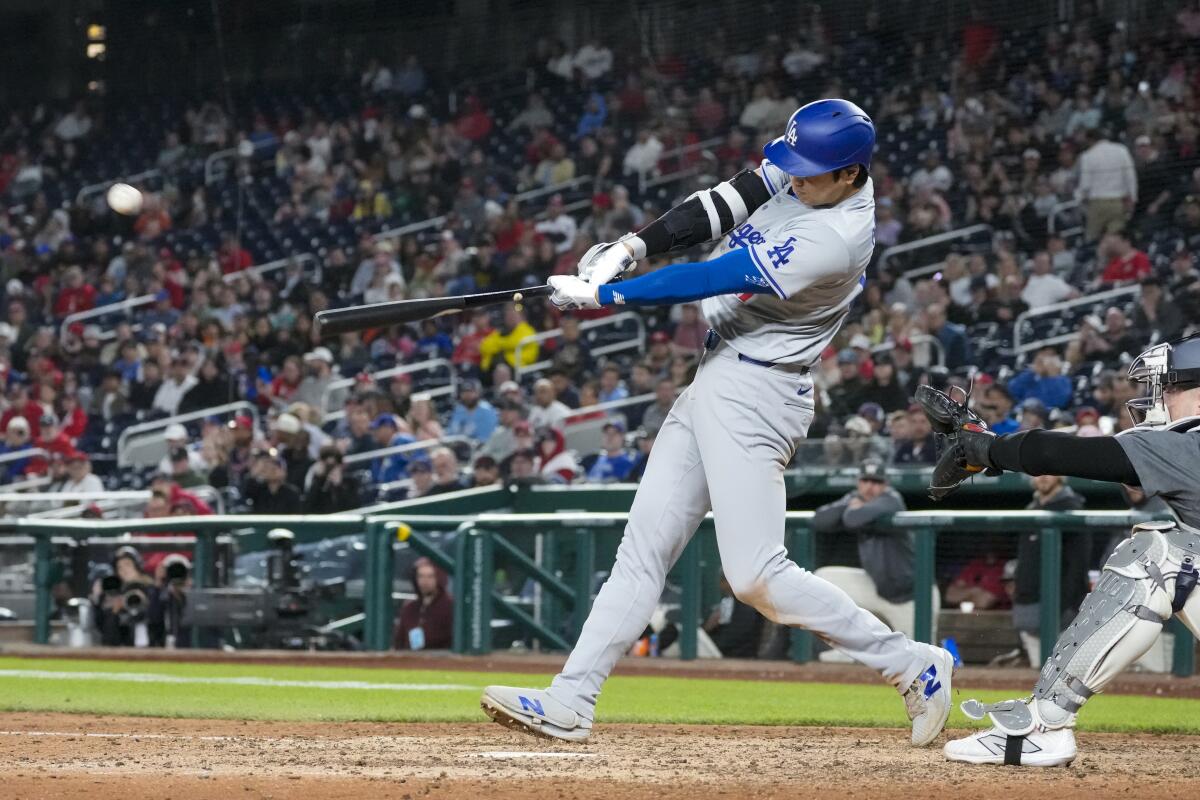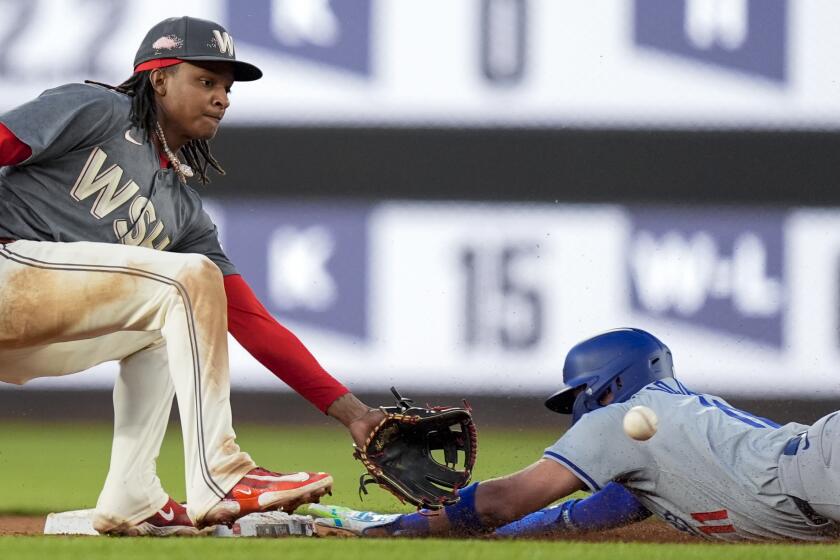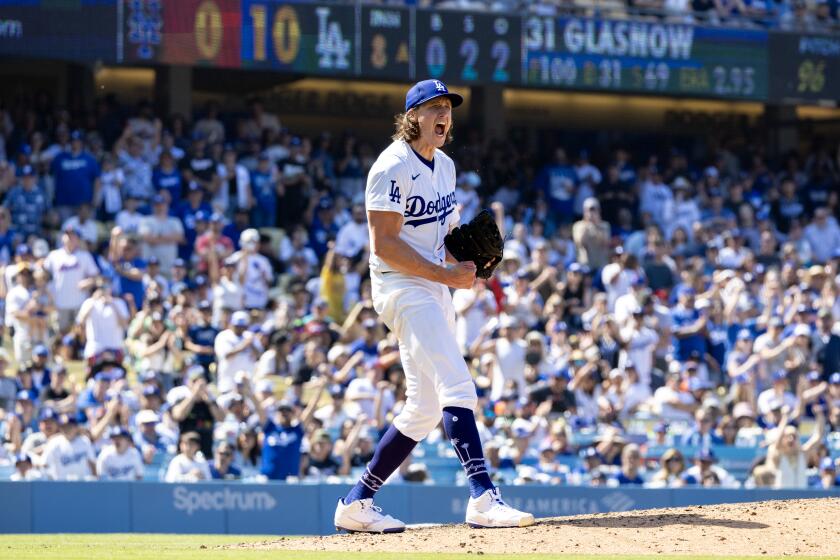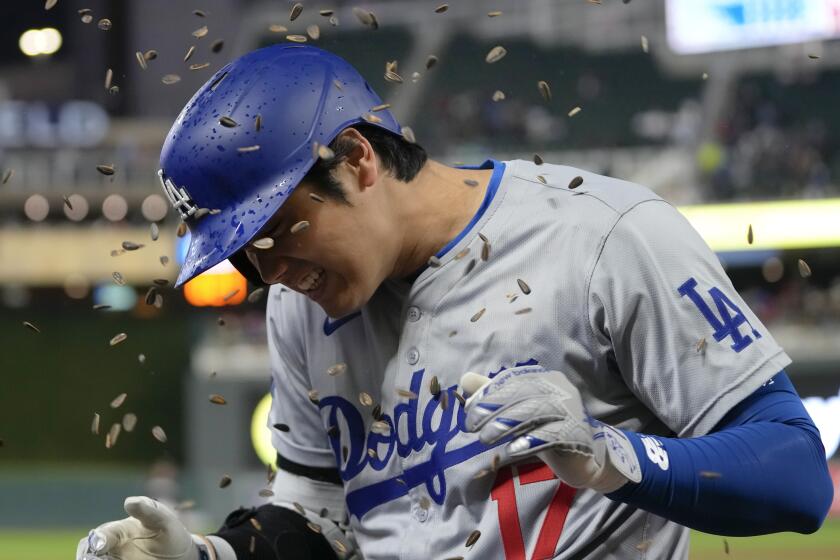How better plate discipline has helped Shohei Ohtani become more dangerous for the Dodgers

- Share via
WASHINGTON — Before the demolition, Shohei Ohtani had to show discipline.
Before hitting the hardest home run of his Major League Baseball career, the Dodgers slugger had to first lay off a pitch that just missed the plate.
If you want a glimpse of what has made Ohtani the most dangerous hitter in the majors the last three weeks — a 17-game stretch in which the two-time most valuable player has batted an MLB-best .424 with six home runs, 11 RBIs and 15 extra-base hits — look no further than his ninth-inning at-bat against Washington Nationals reliever Matt Barnes on Tuesday night.
With the Dodgers leading by two runs, Barnes tried to bait Ohtani with a first-pitch fastball that dived off the inside corner of the plate. It wasn’t a great location, missing the zone by several inches. But it wasn’t an automatic take, either, not for a hitter who sees fastballs at one of the lowest rates in the league and is unafraid of a first-pitch ambush.
This time, though, Ohtani didn’t bite. He recoiled in the box as the heater missed the zone, took a quick step out to readjust his helmet, then dug back in with a 1-and-0 count on his side.
The bullpen relieved a struggling James Paxton and put up all zeroes as the Dodgers defeated the Washington Nationals.
As he has seemingly done more and more recently, Ohtani was sticking to his approach, and waiting for a more enticing mistake somewhere over the heart of the plate.
On the very next pitch, Barnes served one up, hanging a center-cut splitter that Ohtani destroyed with a thumping, thunderous upper-cut swing — sending a scorching line drive into the second deck of Nationals Park to cap the scoring in the Dodgers’ 4-1 victory.
“It looks like a cruise missile,” teammate James Outman said. “That was absurd.”
“There’s a few guys,” manager Dave Roberts added, “that can hit a ball like that.”
The data agreed. According to MLB’s Statcast system, Ohtani’s home run had an exit velocity of 118.7 mph — the hardest of this young MLB season, of Ohtani’s seven-year MLB career, and of any Dodgers hitter since the league started tracking exit velocities in 2015.
Though the blast had a low trajectory with topspin that limited the distance it carried, the ball still sailed 450 feet, crashing into a pocket of empty seats deep in the right-field stands.
“If he hit that with backspin,” third baseman Max Muncy said, “it’s out of the stadium for sure.”
Such physical gifts have been obvious in Ohtani for years now, as the 6-foot-4, linebacker-sized superstar has learned to refine his mechanics and maximize the force of his swing.
Ohtani has ranked top-10 in the majors in average exit velocity every season since 2021. His 50 batted balls of 95 mph or more this season — Statcasts’ threshold for “hard hit” contact — leads all big league hitters. And as a result, Ohtani entered play Wednesday with the best batting average (.364), slugging percentage (.677) and OPS (1.107) in MLB.
“It’s lightning in that bat,” Roberts said. “Any time he swings and makes contact, he can change the game.”
Hammering the ball, however, is only half the battle for Ohtani. Like any hitter, he thrives most when he’s ahead in the count, limiting his chases and attacking pitches in what Roberts likes to call his players’ “nitro zone” — which, for Ohtani, is just about anything up in the strike zone, or down and in.
There’s a reason his hardest exit velocities come when he’s ahead in the count. According to MLB’s Baseball Savant database, Ohtani is averaging over 100 mph of exit velocity when the count is 1-and-1, 2-and-1, 3-and-1 or 2-and-0; and is below 100 mph in all other situations.
Tyler Glasnow strikes out 10 over eight innings and Shohei Ohtani and Andy Pages hit home runs as the Dodgers defeat the Mets 10-0 for a much-needed win.
There’s also a reason why, on the rare occasions Ohtani has struggled this season — such as his .242 average in the first eight games, or his .130 mark with runners in scoring position — it has been his approach where Roberts has seen room for improvement.
The manager noticed that at times Ohtani appeared to expand his strike zone too much, becoming overaggressive on pitches he could do little damage with.
Last week, Roberts decided to approach Ohtani directly with the observation, pulling him aside “just like any other player,” Roberts said, “to make him aware of what I feel he could do better.”
Ohtani’s approach with runners in scoring position was the specific subject of their conversation.
“The zone that I am swinging is a little bit larger with runners in scoring position,” Ohtani said through interpreter Will Ireton. “With nobody on base, I’m pretty good at it. So it’s just widening down the zone. And yes, we talked about it with Doc.”
The notion, though, can apply in every one of Ohtani’s at-bats.
“Being even more disciplined in the strike zone,” Roberts said, “just makes him more scary.”
One example: As Ohtani’s batting average, slugging percentage and home run count have improved in recent weeks, so too has his walk-to-strikeout ratio, drawing 10 free passes against just 12 punchouts in 17 games since April 3.
Another piece of evidence: The ever-changing ways teams have tried to attack — or, rather, neutralize — Ohtani offensively.
Roberts spoke to that point Tuesday, reflecting on the years he and his superstar were in opposite dugouts.
Early in Ohtani’s career, when he faced the Dodgers annually with the Angels, Roberts said Dodgers pitchers focused on one weak spot in Ohtani’s approach, attacking him up in the zone when they weren’t trying to get him to chase.
Shohei Ohtani entered play Monday in the midst of four straight multihit games, the first two of which included his first two Dodgers home runs.
But then, in recent years, Ohtani adjusted, Roberts said. learning to “close that window” and make elevated pitches another no-no when he comes to the plate.
“For a while you could try to go up on him,” Roberts said. “But there’s a lot of risk-reward if you try to do that. You‘ve got to have a lot of confidence if you want to go up the belt.”
On Tuesday night, that’s exactly what Barnes, the Nationals reliever, did while trying to get himself back in the count.
Ohtani, however, was ready as ever, capitalizing on his first-pitch discipline with yet another destructive display.
“[He’s] controlling the strike zone,” Roberts said. “When he does that, it’s hard to get him out.”
More to Read
Are you a true-blue fan?
Get our Dodgers Dugout newsletter for insights, news and much more.
You may occasionally receive promotional content from the Los Angeles Times.










